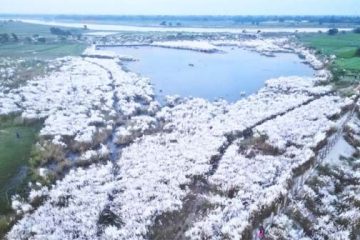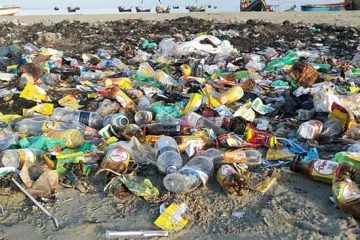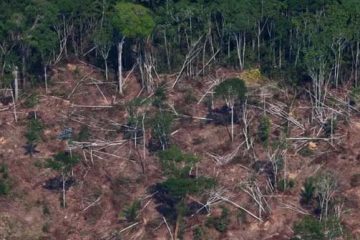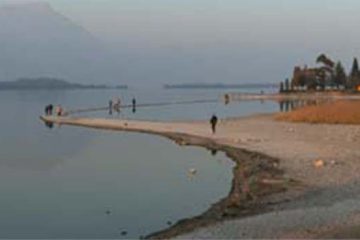Dr. Md. Mizanur Rahman
 Our planet is changing continuously, causing habitats to be altered and modified. Tropial and sub-tropial forests are always subject to destructive natural forces — cyclones landslides, floods, mud flows, volcanic eruptions, fire, drought, and climate change. These factors are overwhelmed by anthropogenic disturbances. These forests are being logged everywhere at a very high rate. Approximately 50% of forest lands have no forest coverage because of human activities.
Our planet is changing continuously, causing habitats to be altered and modified. Tropial and sub-tropial forests are always subject to destructive natural forces — cyclones landslides, floods, mud flows, volcanic eruptions, fire, drought, and climate change. These factors are overwhelmed by anthropogenic disturbances. These forests are being logged everywhere at a very high rate. Approximately 50% of forest lands have no forest coverage because of human activities.
Deforestation is not a recent human activity in the tropical forests. These were inhabited by humans thousands of years back. Charcoal deposits in the sediments of many tropical forests which we know as virgin indicate human activity. Granules of various starchy root vegetables were found on 5000 7000-year-old stone grinding tools of Panama, indicating that people were cultivating agricultural crops in forests from ancient time (Piperno et al., 2000).
Habitat destruction in global context
The mega biodiversity hotspots of the world contain a high degree of endemism and are undergoing gradual habitat loss. Maximum portion of these hotspots are located in tropical forests, which are considered the most endangered. Habitat degradation is one of the major causes of the biodiversity loss. The mega hotspots now consist of only 10% of their former area and 12% of their former primary vegetation. About 1.8% (in Amazonian forests, probably 2.6%) of the tropical forests is disappearing annually. These rates indicate that one Florida per year is being destroyed; one football field is logged per second.
The highest rate of deforestation is occurring in South Asia, where 70% of the areas have been deforested. All tropical forests of South Asia will disappear in less than 50 years if the same rate of deforestation continues. The hotspots will lose 40% of their species if current rates of habitat loss continue, even if for only another decade. These forests will not last beyond the mid-21st century. Plain land forests like Sal forests of Bangladesh are the most threatened because of their accessibility and many useful products — timber, rattan, fruits.
Many of the protected forests exist only on paper. They are small and fragmented, which is detrimental(!) to their continued existence and to the preservation of biodiversity. Many areas are being reforested but these hardly begin to compensate for losses, and they are nothing like the original forest. The new “forests” are simply tree plantations without any of the diversity or richness of the original forest. The destruction of the habitats for most native species is a worse threat than hunting by humans. Usually hunting targets a few individual animals, but habitat destruction affects all species in an area.
Habitat loss occurs in three ways: 1)Whole ecosystems are destroyed or converted into farmland, exotic forests and settlements; 2)Ecosystems are partially removed, creating ‘islands’ surrounded by farmland; 3) Ecosystems are degraded by the loss of species and disruption of their ecological processes. Habitats can either disappear completely or they may become degraded and/or fragmented. Loss of natural forests and the fragmentation of remaining areas into progressively smaller patches is a significant global trend. The habitat degradation occurs in different ways, like in patches (e.g.), in waves (e.g. by urbanization) or as linear (e.g. by construction of roads).
Causes
The tropical forests are often regarded as useless unless “developed” by conversion for agriculture or exploited as sources of wood or rubber. They are also treated as vast sources of land for the relief of social pressures and incomes for the poverty-stricken. The costs of such deforestation are ignored or seen as tolerable in comparison to “non-utilization.”
The following factors are involved for the habitat destruction in the tropics: over-population, faulty land ownership pattern, shifting cultivation, illegal and commercial logging, high demand of timber, scarcity of fuel wood, destruction of natural vegetation, soil disturbances, inadequate valuation of forests as resources, inadequate protection, establishment of infrastructures and transport networks, extractive activities, inappropriate interventions, construction of dams for hydropower sources, poverty, excessive extraction of non-timbering plants, lack of philosophical and ethical attitudes, animal grazing, litter sweeping, encroachment and land grabbing, economic attitudes, greed and corruption, social structures, wars and social conflicts, tourism, introduction of exotic species, overexploitation; and brick field.
Consequences
The consequences of the habitat destruction are: deforestation; losing of existing species; decreasing vegetation coverage; accelerating soil erosion; loss of species richness; increasing rarity; loss of genetic diversity; loss of evolutionary potential; changes in water cycles; changes in water tables; conversion in pure stands; difficulty in aforestation; destruction of natural regeneration, climate change; increasing of physical disturbances; loss of ecosystem services, disruption of livelihoods of indigenous people; social instabilities, economic losses; increasing susceptibility of pathogen infection and insect infestation; loss of forest productivity; increasing environmental refugees; and affecting habitats in proximity of degraded habitat.
Relationship between habitat loss and biodiversity loss
The exact relationship between deforestation rates and loss of biodiversity is unknown. There are many factors in this complex relationship. The removal of a few trees or a few species from a forest may cause a cascade of species losses due to changes in microenvironment. The removal of a “keystone” species may cause disruption of the highly complex interrelationships among species. Extinction rates depend on many factors such as forest type, soil type, level of anthropogenic disturbances, degree of endemism, extent of land degradation, and so forth. When forests become more fragmented and isolated, the organisms in them find it increasingly difficult to survive. Small populations will be unlikely to persevere as their environments change and they are exposed to increasing hunting/gathering pressures and stress. Both population size and species richness decrease as the habitat abundance decreases.
Rare and patchily distributed species requiring a large range seem particularly susceptible to habitat destruction. Larger patches contain more species than do small patches. Small fragments experience more extinction and receive fewer immigrants. Small fragments or islands that are more remote from the mainland or source population have fewer species because the extinction rate is the same but the immigration rate is lower. Most of the species are composed of relatively few individuals, randomly distributed throughout the geographical range of that species, or located in one small area only (endemism). Many tropical forest species require large and undisturbed forest; they cannot thrive in degraded habitats. The fragmented forests do not contain the full range of forest species.
About 50% of the world’s species are threatened with extinction due to deforestation. Tropical deforestation involves the conversion of continuous forest to the remnant of forest patches set in a matrix of non-forest vegetation. The altered microclimate becomes unsuitable for certain species by increasing mortality rates near the edge and reducing recruitment to their populations.
The tropical forest ecosystem is often characterized by a heavy dependency on mutualistic species interactions for its stability. Many plant species in the tropical forests are reliant on animals as agents of dispersal for either pollen or seeds or both. Habitat destruction causes the extinction of certain important pollinating or seed-dispersing animals which severely limits regeneration of rare plant species and hence initiates an extinction vortex.
Heavily fragmented forests do not support a home range for larger species. Larger species may have trouble finding habitat in not sufficient density to support a home range in heavily fragmented forests. Fragment size, degree of isolation and time since excision from the continuous forest directly influence the biodiversity of a fragmented habitat.
Species also tend to suffer from genetic drift and inbreeding in degraded habitat. Immigration is an important phenomenon for the maintenance of high local levels of diversity in tropical forests. In distant fragments the rare species will die out relatively rapidly and not be replaced by other species because of a failure of immigration. Fragment edges are inhospitable to most of the forest species. The deforested matrix of a fragmented landscape is often dominated by alien species, because few of the native species are tolerant of the extremely exposed conditions. Habitat loss is the primary cause of species endangerment.
Habitat and biodiversity loss in Bangladesh
Huge population pressure and widespread poverty are main frontier of habitat degradation in Bangladesh. Due to high population density and sharply skewed distribution of lands, the forest resources are overexploited. Per capita forestland in the country is around 0.02 ha and the existing natural forests are decreasing at a rate varying from 2.1% /yr to 3.3% /yr. Massive habitat destruction occurred in the Sal forests of Bangladesh. The recurrent anthropogenic disturbances in the Sal forests have rendered the system inhospitable for the regeneration and growth of wild plant associates, causing a net loss in plant diversity. No single part of the Sal forests can be found as undisturbed natural forest.
Logging, regeneration destruction, litter sweeping, animal grazing and soil disturbances are common in all forest areas. Recreational activities like picnic are an additional human pressure in the Sal forests. One can hardly find native species such as Gandhigajari, Ajuli, Dud Kuruj, Sonalu, Cheshra, Jiga, Jogini Chakra, Kaika, Sidha, Sajna, Amloki, Bohera, Roina, Lalmoina, Tamal, Khailadamor, Haldu, Bhutum, Kurchi, Mohuya, Kharajora, Kanaidinga, Kukurchita, Katakhai, Udhal, Sheora, Pahariamra, Awal, Koroch, Bajna, Joina, Debdaru, Arjun and Behula.
The hydro-electricity project, ethnic conflict, encroachment, jhum cultivation are the main causes of hill deforestation. Poverty, profit-making, natural disaster, salinity and sedimentation are the major causes of Sundarbans degradation. The vast degradation of Sundari trees is of course caused by high salinity. Different types of types diseases and illegal logging are also responsible for deforestation in the Sundarbans. Lack of alternative livelihood push the coastal people to depend on mangrove forest products. Hog deer, water buffalo, swamp deer, Javan rhinoceros, single horned rhinoceros and the mugger crocodile became extinct at the beginning of the last century from Sundarbans due to habitat destruction.
Different studies show that all our natural old forests have become critically fragmented to the point where they are considered unlikely to maintain adequate level of biodiversity, nor support viable populations of natural and native species of flora and fauna. Abundant species have become occasional, occasional become rare, rare become very rare and very rare just extinct. Once upon a time, Sal forests of Bangladesh were sweet home for beautiful Capped Langur. Now it is threatened by habitat loss and has become an IUCN- red listed species. Less than a hundred years ago, tigers prowled all across the Indian sub-continent. But increasing habitat loss has contracted the tigers’ former range. Tigers need large territories for roaming and preying.
About 95% population of Western Hoolock Gibbons in Bangladesh will be lost over the next two decades based on the current rate of habitat destruction. Now Asian Elephant is the largest critically endangered terrestrial animal in Bangladesh.
The major cause of the is habitat destruction. There has been rampant habitat loss of Marbled and Fishing Cat throughout the Sal forests over the past 20 years. Habitat destruction throughout South Asia is occurring at an alarming rate to the peril of biodiversity.
Necessity of conservation
The core of ‘the Convention on Biological Diversity (CBD)’ is the promotion of an integrated approach to natural resources management on large landscapes and to biodiversity conservation through enhancing wildlife habitat and reducing habitat fragmentation. Serious attention should be paid to; conservation of biodiversity; prudent extraction of forest products; preserving genetic resources; maintaining hydrological functions; improving air quality, retention of soil fertility; controlling pests; proper pollination; balancing aesthetic factors and recreation; maintaining wilderness; and ethical values.
Mitigation
o Reducing human population growth in forests
o Improving land use pattern and protecting forest lands
o Adopting sustainable forest development
o Introducing biological corridors
o Maintaining buffer zones in between core and peripheral zones
o Changing policies towards forests
o Involving indigenous peoples and traditional communities in conservation programme
o Strengthening forest monitoring, research and development, education, and capacity building to maintain a “cradle” of biodiversity within the core areas of each protected forest
o Improving agricultural methods and productivity
o Improving legal systems
o Stopping introduction of alien invasive species
o Gap filling by rare tree species
o Aforestation and reforestation by native and natural species
o Facilitating natural regeneration in degraded forests
o Leaving denuded forest lands untouched for 20 years to promote natural succession
o Stopping further clear felling and illegal logging
o Protecting natural regenerations (seedling, sapling and juvenile trees) from cutting
o Introducing pioneer and early successional species in the degraded forests
o Taking effective actions against encroachers and land grabbers
o Establishing gene banks to conserve the gene pool of endangered species
o Bringing endangered animals in captivity for breeding
o Reducing social and economic imbalances
o Minimising anthropogenic disturbances
o Establishing national centers for conservation of threatened and endangered species
o Increasing basic research on the impact of forest degradation
o Considering conservation programme as ‘asset’ in economic calculations
o Taking appropriate actions against animal poaching
o Alleviating poverty alleviation in the adjacent areas of forests
o Emphasizing on community based conservation
o Establishing more protected areas
o Searching for alternative fuel sources in the forest and adjacent areas
o Creating alternative livelihoods for the indigenous people
o Improving environmental education
o Taking care of secondary and successional forests
Dr. Md. Mizanur Rahman, a biodiversity specialist, is Assistant Commissioner, Jhalakathi Collectorate, E-mail: mizan_peroj @yahoo.com





